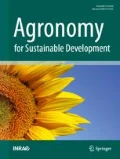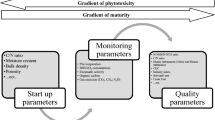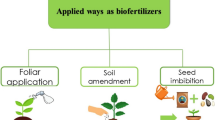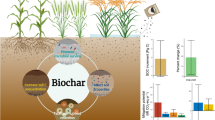Abstract
Pollution of agricultural ecosystems is due to the excessive use of mineral fertilizers and mass discharge of livestock manure. Therefore, there is a need for disposing manure safely, for instance by transforming manure into valuable compost. Traditional composting is, however, time-consuming with considerable nutrient losses. Vermicomposting is an alternative method, but so far, there are few quantitative evaluations of vermicomposting. We therefore compared vermicomposting and traditional composting of cattle manure with maize. Our results show that the amount of nutrients from vermicomposting is lower than that from traditional composting. Nonetheless, vermicomposting yielded 2172.0 kg of earthworms per hectare, which provided an additional income of US$4008.1 to farmers. Moreover, vermicomposting increased aboveground biomass by 7.7 % and maize grain yield by 18.3 %. The global output of vermicomposting was thus higher by 304 % due to higher grain yield and earthworm income.
Similar content being viewed by others
1 Introduction
Traditional agriculture is currently characterized by excessive inputs of chemical fertilizers, pesticides, and herbicides, while the insufficient application of organic fertilizers (Li et al. 2007; Gill and Garg. 2014). The excess use of chemical fertilizers and pesticides has resulted in numerous negative effects on the environment, including water, soil (Ju et al. 2009), and food pollution (Li et al. 2007), degradation of soil quality (Ju et al. 2009), and losses of agricultural biodiversity (Minuto et al. 2006; Gill and Garg. 2014). To solve such problems, more sustainable agricultural practices are urgently required. Compared with chemical agriculture, organic farming has been thoroughly proven as beneficial in maintaining both biodiversity and environmental sustainability (Ahmad et al. 2007; Leite et al. 2010). Organic farming has been gradually adopted by agriculturalists, particularly in developed countries (Rigby et al. 2001; Lobley et al. 2009), because of its higher economic and ecological benefits.
The production of livestock manure has extensively increased with increasing human populations, industrialization, and intensive agriculture (Tripathi and Bhardwaj 2004). The mass discharge of livestock manure has also caused many environmental problems, such as offensive odors and the contamination of groundwater and soil (Edwards and Bater 1992; Garg et al. 2006). The conversion of a waste into a beneficial material could play an important role in resource recycling and environmental cleaning (Tripathi and Bhardwaj 2004; Yadav and Garg 2011).
Although various methods of livestock manure disposal are currently in use, including physical, chemical, and microbiological techniques, these methods are time-consuming and labor intensive (Garg et al. 2006). For example, traditional compost was usually carried out by the windrow system: The manure was windrowed and stirred several times by labor or special machine, with the period being 1–3 months (Wei et al. 1999; Li et al. 2000). Traditional composting is simple and cheap but does not make full use of livestock manure, with considerable nutrient losses (Wei et al. 1999; Eklind and Kirchmann 2000; Li et al. 2000). Vermicomposting has been reported to be a cost-effective, viable, and rapid technique for the efficient management of livestock manure (Fig. 1) (Garg et al. 2006). Earthworm activity not only accelerates the decomposition of organic matter (Atiyeh et al. 2001; Lv et al. 2013) but also makes nutrients available for plant growth (Tripathi and Bhardwaj 2004; Garg et al. 2006). Therefore, the composting of livestock manure could help reduce the environmental pollution caused by this waste while providing a healthier alternative from chemical fertilizer to organic farming (Atiyeh et al. 2002).
From the aforementioned facts, this paper hypothesized that the digestion of cattle manure by earthworms would lead to the fuller use of the nutrients in this waste, with plentiful earthworms being obtained. However, it remained uncertain whether applying this remainder compost product to fields would generate equal or greater yields and more economic benefits than applying traditional compost in agricultural system. Therefore, this paper conducted a study about the same cattle manure treated by vermicomposting and traditional composting, and their remainder valuable compost products were applied into the fields, respectively. The aims of the investigation were as follows: (1) to investigate effects of vermicomposting and traditional composting on nutrients of the cattle manure; (2) to investigate maize yield in plots fertilized with cattle manure vermicompost and traditional compost, respectively; and (3) to compare the inputs and outputs of the two different systems (cattle manure-vermicompost-maize system, cattle manure-traditional compost-maize system) comprehensively, and determine if the field application of cattle manure digested by earthworms generated greater economic benefits.
2 Materials and methods
2.1 Experimental site
The experimental site is located at the Eco-farming Research Station of Shandong Agricultural University, based in Jiang Jiazhuang Village, Pingyi County, Shandong Province, Eastern China (35° 26′ 21″ N, 117° 50′ 11″ E). The area experiences a typical temperate and monsoonal climate, with a mean annual rainfall of 770.2 mm and average annual temperature of 13.2 °C. The soil type is brown. Before the application of fertilizer, the experimental soil (0–20 cm) contained organic matter, 1.22 %; total nitrogen, 0.08 %; available P, 14.93 mg kg−1; and available K, 144.96 mg kg−1.
2.2 Collection of cattle manure and earthworms
Both cattle manure and earthworms (Eisenia fetida) were obtained from Hongyi Organic Farm in Jiang Jiazhuang Village. Before composting, the experimental cattle manure contained organic matter, 54.14 %; total nitrogen, 1.87 %; available P, 0.24 %; and available K, 0.52 %, and had a pH of 8.63.
2.3 Experimental design
This study was conducted in two different systems, cattle manure-vermicompost-maize system (VC system) and cattle manure-traditional compost-maize system (TC system).
In the VC system, cattle manure (30 t, dry weight) was shaped into cuboids with width 1.5 m and height 0.2 m. A total of 309 kg earthworms was added into the cattle manure (Guo 2012). Water was sprinkled daily onto the manure using a sprayer to maintain a moisture level of 55–65 %. After 60 days, the earthworms were separated from the cattle manure, the remainder cattle manure vermicompost was applied into the field 1 (1 ha) before tillage.
In the TC system, cattle manure (30 t, dry weight) was shaped into cuboids with width 1.5 m, height 0.5 m, and moisture 60–70 % and then covered with plastic film, stirred, and mixed every 20 days. After 60 days, the remainder cattle manure traditional compost was applied into the field 2 (1 ha) before tillage.
Three completely randomized experimental plots were selected in each field; each plot was 2.4 × 5 m. The experimental crop was the ordinary high-yield maize Zhengdan 958. The maize was sown on June 21, 2011 and harvested on September 30, 2011. The distance between rows was 0.6 m, and the distance between plants was 0.27 m.
2.4 Sampling and chemical analysis
After 60-day composting, cattle manure vermicompost and traditional compost samples were drawn by using an auger with the bore of 6 cm. Five random sites in the same compost plot were selected and the samples were taken from top to bottom; the five random subsamples were pooled together and air-dried for nutrients analysis. Determination of pH was done by a digital pH meter (PB-10, Sartorius, Germany). Nutrient estimations involved Walkle and Black (1934) method for organic matter, macro-kjeldahl method for total N, sodium bicarbonate extractable method (Olsen et al. 1954) for available P, and ammonium acetate extractable method (Simard 1993) for available K. All the determinations were carried out in triplicate.
Dry matter of total aboveground biomass was measured two times during the growing season, at flowering and at harvest stage. The aboveground biomass included corn stem, leaves, corncob, and kernels. The whole maize plant was cut on the bottom close to the ground and was transported to the laboratory to segment and then dried at 105 °C for 30 min and at 75 °C until reaching a constant weight.
At maize harvest, three replicates of 10 consecutive plants in the same row were selected. The grain and fresh straw yields were measured for each replicate.
2.5 Statistical analysis
Data regarding economic benefits were scaled to 1 ha based on historic data collected from Hongyi Organic Farm and the present experiment. Input refers to the costs for purchasing seeds, fertilizers, plastic films, sprayers, and earthworms; cultivating, irrigation seeding, and crop harvesting; and applying fertilizer and controlling pests and weeds. Output includes the sales of earthworms, maize grain, and fresh straw.
All data were analyzed using one-way analysis of variance (ANOVA) and nonparametric tests with SPSS 17.0 at the 0.05 level. Differences between treatments were considered significant if P ≤ 0.05. Analyses were performed in Sigma Plot 10.0 (Aspire Software Intl. Ashburn, VA, USA).
3 Results and discussion
3.1 Changes of nutrient contents and pH in cattle manure
We found that the nutrient contents, total quantities of nutrients, and pH of cattle manure were greatly changed after traditional composting and vermicomposting. Composting, particularly vermicomposting, significantly decreased pH (P ≤ 0.05). The total quantities of organic matter and N have significantly (P ≤ 0.05) decreased after composting, due to decomposition of organic matter and N losses (Shi et al. 2010). Organic matter and total N content were also decreased; however, the available P and K content increased, except for available K in vermicompost (Table 1). These results are in support of previous research that composting can make nutrients more available (Tripathi and Bhardwaj 2004; Garg et al. 2006) while vermicomposting results in lower pH (Yang, et al. 2014). The total N and available K content were more significant in traditional compost than that in vermicompost (P ≤ 0.05). Organic matter content was also higher in traditional compost than that in vermicompost, but the difference was not significant (P ≥ 0.05). The total quantities of organic matter and N, and available P and K were significantly higher in traditional compost than those in vermicompost (P ≤ 0.05, Table 1). This might be because earthworms and microbes require carbon as energy source and nitrogen to build proteins (Ahmad et al. 2007). Although carbon and nitrogen were consumed, plentiful additional earthworms were obtained (Table 2); simultaneously, the activities of earthworms convert the cattle manure into a finely divided, peat-like vermicompost, with higher porosity, aeration, drainage, water-holding capacity, and microbial activity being achieved (Edwards and Burrows 1988; Atiyeh et al. 2001). The results indicated that vermicomposting might fully use nutrients of the cattle manure and convert the wasteful cattle manure into valuable organic fertilizer that is friendly to the environment.
3.2 Dry weight of total aboveground biomass
Dry weight of total aboveground biomass was influenced by cattle manure vermicompost and traditional compost application (Fig. 2). At the flowering stage, the dry weight of total aboveground biomass in the plots fertilized with traditional compost was 7.1 % higher than that in the plots fertilized with cattle manure vermicompost (Fig. 2A). That might be because the main nutrients in traditional compost were higher at the beginning (Table 1). However, at the harvest stage, the dry weight of total aboveground biomass was 7.7 % higher in the plots fertilized with vermicompost (Fig. 2B). Although both vermicompost and traditional compost are considered to be slow-release fertilizers, the former differed from the latter in being a product of the biodegradation and stabilization of organic materials through the interaction between earthworms and microorganisms (Chaoui et al. 2003; Arancon et al. 2005; Singh et al. 2008).
Dry weight of total aboveground biomass per maize plant was lower at flowering stage, but higher at harvest stage in the vermicompost system. Values are mean ± SE (n = 3). The different letters in the same figure indicate significant differences at P ≤ 0.05. Traditional compost: cattle manure-traditional compost-maize system; vermicompost: cattle manure-vermicompost-maize system
Vermicompost contains plant-growth-regulating materials, such as humic acids (Senesi et al. 1992; Masciandaro et al. 1997; Atiyeh et al. 2002), auxins, gibberellins, and cytokinins (Krishnamoorthy and Vajrabhiah 1986; Tomati et al. 1988, 1990; Singh et al. 2008). These regulators are produced through the action of earthworms and microbes such as fungi and actinomycetous bacteria, which increase the plant growth and yield of many crops (Tomati et al. 1988; Atiyeh et al. 2002). Traditional compost can also provide nutrients for plant to grow, but its salinity, N immobilization, and pathogen levels may be problematic (Sims 1990; O’Brien and Barker 1996; Chaoui et al. 2003). Previous researchers have compared the effects of composting and vermicomposting and reported that vermicompost possesses a lower C/N ratio, higher protein/organic C ratio, and greater levels of N (Vinceslas-Akpa and Loquet 1997). Others have reported that vermicomposts are efficient sources of plant nutrients and that they are less likely to produce salinity stress in containers as compared to compost and synthetic fertilizers (Chaoui et al. 2003). So the plants fertilized with cattle manure vermicompost grown better than those nourished with traditional compost in the later stage.
3.3 Maize yield
Maize yield was also influenced by cattle manure vermicompost and traditional compost application (Fig. 3). The grain yield in plots fertilized with cattle manure vermicompost was significantly greater than that fertilized with traditional compost at the harvest stage (P ≤ 0.05, Fig. 3B). Although the biomass of maize straw in plots fertilized with cattle manure vermicompost was lesser than that fertilized with traditional compost, the difference was not significant (P > 0.05, Fig. 3A).
The biomass of maize straw and maize grain yield in the different systems. The grain yield was significant higher in the vermicompost system. Values are mean ± SE (n = 3). The different letters in the same figure indicate significant differences at P ≤ 0.05. Traditional compost: cattle manure-traditional compost-maize system; vermicompost: cattle manure-vermicompost-maize system
Because vermicompost differed from the traditional compost, application of cattle manure vermicompost provided more plant regulator to promote plant absorbing more nutrients which further promoted the dry matter transferring to maize grain. As the nutrients in vermicompost were lesser than those in traditional compost, the higher yield performance indicated that vermicomposting facilitates more complete use of these nutrients in comparison with traditional composting.
3.4 Economic benefits
The grain yield is not the single factor considered by farmers; actually, the economic benefits are of greater importance. We found that the net output was higher (US$3956) in the VC system, increased by 304.1 % compared with the TC system. Although the inputs for vermicomposting were higher than those for traditional composting, plentiful earthworms were obtained from the former treatment, and application of cattle manure vermicompost harvested greater grain yield which led to a higher output. In the end, the ratio of output/input (1.9:1) was higher in the VC system than that (1.5:1) in the TC system (Table 2). The above mentioned results powerfully proved that cattle manure treated by vermicomposting and its application generated more economic benefits.
4 Conclusions
The digestion of cattle manure by earthworms converts the wasteful cattle manure into more valuable organic fertilizer that is friendly to the environment. Some nutrients are used by earthworms, and plentiful earthworms have been obtained. The activities of earthworms made the remainder compost product contain some plant growth regulators which led to the plant to fully use the agronomic nutrients to generate greater aboveground biomass and higher grain yield. Thanks to the harvest of earthworms and increased grain yield, both net output and ratio of output/input in the VC system were higher, even its input was simultaneously elevated. Our findings may help to sustainably increase food supply by improving soil conditions, protecting environments, and maintaining crop yields through vermicompost application.
References
Ahmad R, Jilani G, Arshad M, Zahir ZA, Khalid A (2007) Bio-conversion of organic wastes for their recycling in agriculture: an overview of perspectives and prospects. Ann Microbiol 57:471–479. doi:10.1007/BF03175343
Arancon NQ, Edwards CA, Bierman P, Metzger JD, Lucht C (2005) Effects of vermicomposts produced from cattle manure, food waste and paper waste on the growth and yield of peppers in the field. Pedobiol 49:297–306. doi:10.1016/j.pedobi.2005.02.001
Atiyeh RM, Edwards CA, Subler S, Metzger JD (2001) Pig manure vermicompost as a component of a horticultural bedding plant medium: effects on physicochemical properties and plant growth. Bioresour Technol 78:11–20. doi:10.1016/S0960-8524(00)00172-3
Atiyeh RM, Lee SS, Edwards CA, Arancon NQ, Metzger J (2002) The influence of humic acid derived from earthworm-processed organic waste on plant growth. Bioresour Technol 84:7–14. doi:10.1016/S0960-8524(02)00017-2
Chaoui HI, Zibilske LM, Ohno T (2003) Effects of earthworm casts and compost on soil microbial activity and plant nutrient availability. Soil Biol Biochem 35:295–302. doi:10.1016/S0038-0717(02)00279-1
Edwards CA, Bater JE (1992) The use of earthworm in environmental management. Soil Biol Biochem 24:1683–1689. doi:10.1016/0038-0717(92)90170-3
Edwards CA, Burrows I (1988) The potential of earthworm compost as plant growth media. In: Edwards CA, Nauhauser A (eds) Earthworm in environmental and waste management. Springer, Netherlands, pp 211–220
Eklind Y, Kirchmann H (2000) Composting and storage of organic household waste with different litter amendments II: nitrogen turnover and losses. Bioresour Technol 74:125–133. doi:10.1016/S0960-8524(00)00005-5
Garg P, Gupta A, Satya S (2006) Vermicomposting of different types of waste using Eiseniafoetida: a comparative study. Bioresour Technol 97:391–395. doi:10.1016/j.biortech.2005.03.009
Gill HK, Garg H (2014) Pesticide: environmental impacts and management strategies. In: Solenski S, Larramenday ML (eds) Pesticides-toxic effects. Intech. Rijeka, Croatia, pp 187–230
Guo LY (2012) Earthworms compost cattle dung and the effects of vermicompost on the growth and quality of soybean and maize. Dissertation, Shandong Agricultural University
Ju XT, Xing GX, Chen XP, Zhang SL, Zhang LJ, Liu XJ, Cui ZL, Yin B, Christie P, Zhu ZL (2009) Reducing environmental risk by improving N management in intensive Chinese agricultural systems. PNAS 106:3041–3046. doi:10.1073/pnas.0813417106
Krishnamoorthy RV, Vajrabhiah SN (1986) Biological activity of earthworm casts: an assessment of plant growth promoter levels in casts. P Anim Sci 95:341–351. doi:10.1007/BF03179368
Leite LFC, Oliveira FC, Araújo ASF, Galvao SRS, Lemos JO, Silva EFL (2010) Soil organic carbon and biological indicators in an acrisol under tillage systems and organic management in Northeastern Brazil. Aust J Soil Res 48:258–265. doi:10.1071/SR09122 0004-9573/10/030258
Li YX, Wang MJ, Wang JS, Chen TB (2000) The technology of municipal solid wastes composting. Techniques and Equipment for Environ Pollut Control 1:39–45
Li ML, Gu J, Gao H, Qin QJ, Liu MJ (2007) Effects of different organic fertilizer on plant character, quality and yield of soybean. J Northwest A & F Univ (Nat Sci Edit) 35:67–72
Lobley M, Butler A, Reed M (2009) The contribution of organic farming to rural development: an exploration of the socio-economic linkages of organic and non-organic farms in England. Land Use Policy 26:723–735. doi:10.1016/j.landusepol.2008.09.007
Lv BY, Xing MY, Yang J, Qi WS, Lu YS (2013) Chemical and spectroscopic characterization of water extractable organic matter during vermicomposting of cattle dung. Bioresour Technol 132:320–326. doi:10.1016/j.biortech.2013.01.006
Masciandaro G, Ceccanti B, Gracia C (1997) Soil agro-ecological management: fetigation and vermicompost treatments. Bioresour Technol 59:199–206. doi:10.1016/S0960-8524(96)00142-3
Minuto A, Davide S, Garibaldi A, Gullino ML (2006) Control of soil borne pathogens of tomato using a commercial formulation of Streptomyces griseoviridis and solarization. Crop Prot 25:468–475. doi:10.1016/j.cropro.2005.08.001
O’Brien TA, Barker AV (1996) Evaluation of ammonium and soluble salts on grass sod production in compost. I. addition of ammonium or nitrate salts. Commun Soil Sci Plan 27:57–76. doi:10.1080/00103629609369544
Olsen SR, Cole CV, Watanabe FS, Dean LA (1954) Estimation of available phosphorus in soils by extraction with sodium bicarbonate. Circ US Dep Agric 939
Rigby D, Young T, Burton M (2001) The development of and prospects for organic farming in the UK. Food Policy 26:599–613. doi:10.1016/S0306-9192(01)00023-9
Senesi N, Saiz-Jimenez C, Miano TM (1992) Spectroscopic characterization of metal-humic acid-like complexes of earthworm-composted organic wastes. Sci Total Environ (117–118):111–120. doi:10.1016/0048-9697(92)90079-8
Shi C, Zhang XE, Sha YFJML, Jin JX, Huang CF, Jia HT (2010) Dynamic changes of total N, P, K and organic matter by different treatments on cattle manure composting. China Cattle Sci 36:26–29
Simard RR (1993) Ammonium acetate expectable elements. In: Martin R, Carter S (eds) Soil sampling and method of analysis. Lewis Publisher, Florida, pp 39–43
Sims JT (1990) Nitrogen mineralization and elemental availability in soils amended with composted sewage sludge. J Environ Qual 19:669–675. doi:10.2134/jeq1990.00472425001900004007x
Singh R, Sharma RR, Kumar S, Gupta RK, Patil RT (2008) Vermicompost substitution influences growth, physiological disorders, fruit yield and quality of strawberry (Fragaria x ananassa Duch.). Bioresour Technol 99:8507–8511. doi:10.1016/j.biortech.2008.03.034
Tomati U, Grappelli A, Galli E (1988) The harmone-like effect of earthworm casts on plant growth. Biol Fert Soils 5:288–294. doi:10.1007/BF00262133
Tomati U, Galli E, Grappelli A, Dihena G (1990) Effect of earthworm casts on protein synthesis in radish (Raphanus sativum) and lettuce (Lactuca sativa) seedlings. Biol Fert Soils 9:288–289. doi:10.1007/BF00634102
Tripathi G, Bhardwaj P (2004) Decomposition of kitchen waste amended with cow manure using an epigeic species (Eisenia fetida) and an anecic species (Lampito mauritii). Bioresour Technol 92:215–218. doi:10.1016/j.biortech.2003.08.013
Vinceslas-Akpa M, Loquet M (1997) Organic matter transformations in lignocellulosic waste products composted or vermicomposted (Eisenia fetida andrei): chemical analysis and 13C CPMAS NMR spectroscopy. Soil Biol Biochem 29:751–758. doi:10.1016/S0038-0717(96)00201-5
Walkle A, Black IA (1934) An examination of the degtjareff method for determining soil organic matter and prepared modifications of the chromic acid titration method. Soil Sci 34:29–38. doi:10.1097/00010694-193401000-00003
Wei YS, Wang MJ, Wang JS (1999) State of the art of composting. Advances in Environ Sci 7:11–23
Yadav A, Garg VK (2011) Recycling of organic wastes by employing Eisenia fetida. Bioresour Technol 102:2874–2880. doi:10.1016/j.biortech.2010.10.083
Yang J, Lv BY, Zhang J, Xing MY (2014) Insight into the roles of earthworm in vermicomposting of sewage sludge by determining the water-extracts through chemical and spectroscopic methods. Bioresour Technol 154:94–100. doi:10.1016/j.biortech.2013.12.023
Acknowledgments
This study was co-supported by the Key Strategic Project of the Chinese Academy of Sciences (KSZD-EW-2-012) and Shandong Province Taishan Scholarship (No. 00523902). We thank all the staffs of Hongyi Organic Farm for providing accommodation and the field facilities, especially Mr. Jiang Gaoliang, Ms. Zhou Quan’ai, and Mr. Jiang Qingli. We also thank all the researchers who have given us help during the study.
Author information
Authors and Affiliations
Corresponding author
Additional information
Liyue Guo and Guanglei Wu contributed equally to this work.
About this article
Cite this article
Guo, L., Wu, G., Li, C. et al. Vermicomposting with maize increases agricultural benefits by 304 %. Agron. Sustain. Dev. 35, 1149–1155 (2015). https://doi.org/10.1007/s13593-015-0307-0
Accepted:
Published:
Issue Date:
DOI: https://doi.org/10.1007/s13593-015-0307-0







